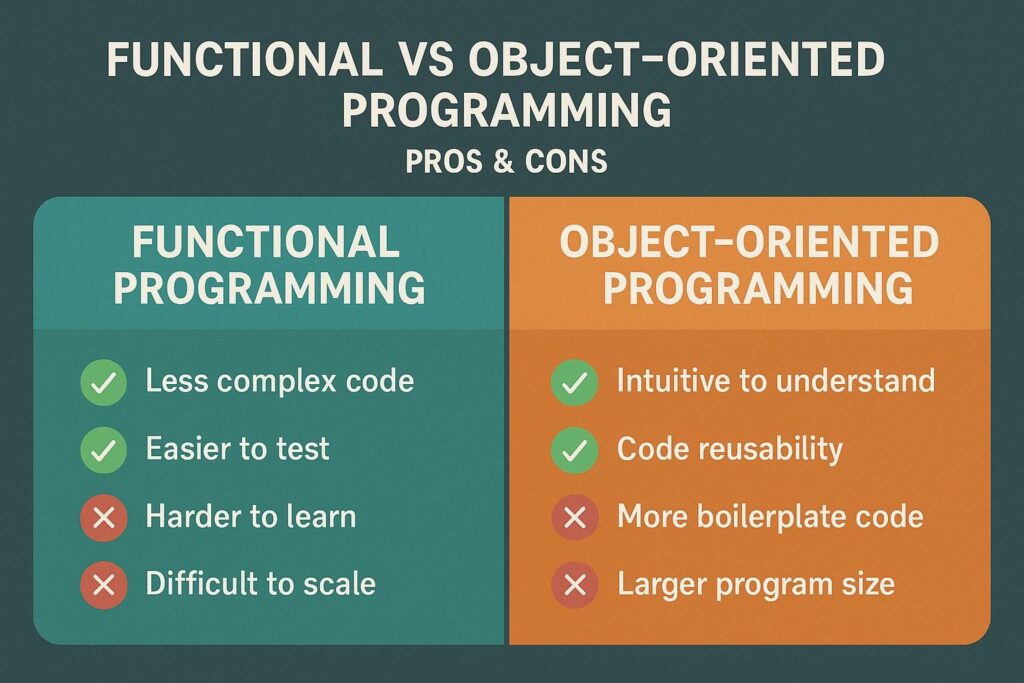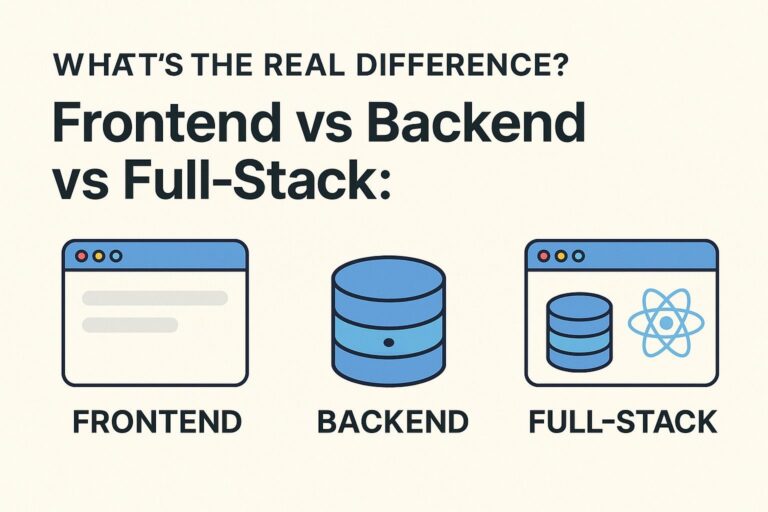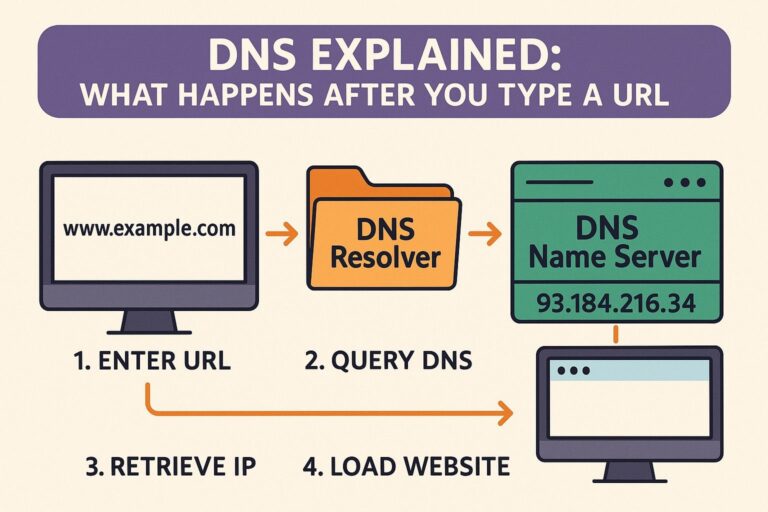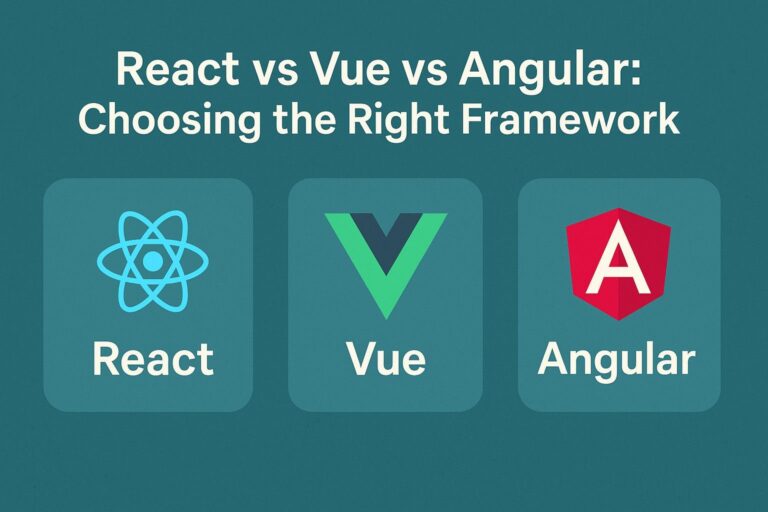
In software development, the way we design, structure, and write code is heavily influenced by programming paradigms. Two of the most prominent paradigms—Functional Programming (FP) and Object-Oriented Programming (OOP)—provide fundamentally different approaches to problem-solving.
Understanding the differences between these paradigms helps developers choose the right strategy depending on the project requirements, team experience, and performance goals. This guide explores the principles, strengths, weaknesses, and real-world use cases of both paradigms to help you make informed decisions.
What Is Functional Programming?
Functional Programming is a declarative programming paradigm that emphasizes the use of pure functions, immutable data, and stateless computation. It treats computation as the evaluation of mathematical functions and avoids state changes and side effects.
Instead of commanding how a task should be performed step-by-step, FP focuses on what needs to be done by composing small, reusable functions.
Key Characteristics of Functional Programming
- Pure Functions: Produce the same output for the same input without modifying any external state.
- Immutability: Once a data structure is created, it cannot be changed.
- First-Class and Higher-Order Functions: Functions can be assigned to variables, passed as arguments, and returned as results.
- Function Composition: Smaller functions can be combined to build more complex operations.
- Recursion Instead of Loops: FP favors recursion over traditional looping constructs.
- Declarative Code Style: Code expresses the logic of computation without describing control flow.
Languages That Emphasize FP
- Haskell (pure functional)
- Lisp
- Elixir
- F#
- Erlang
- Scala (multi-paradigm)
- JavaScript (supports FP features)
What Is Object-Oriented Programming?
Object-Oriented Programming is an imperative paradigm that models software as objects, which are instances of classes that encapsulate data and behavior. OOP reflects real-world entities and their interactions, which makes it intuitive for building complex systems.
The paradigm promotes modularity, encapsulation, inheritance, and polymorphism to organize code in a scalable, maintainable way.
Key Characteristics of Object-Oriented Programming
- Encapsulation: Combines data (attributes) and methods (functions) into a single entity called a class.
- Abstraction: Hides internal complexity from the outside world.
- Inheritance: Enables the reuse of code through hierarchical class relationships.
- Polymorphism: Allows entities to behave differently depending on context.
- Stateful Objects: Objects can maintain and change their internal state over time.
- Imperative Code Style: Emphasizes detailed instructions to perform tasks step-by-step.
Languages That Embrace OOP
- Java
- C++
- Python
- Ruby
- C#
- Kotlin
- Swift
Detailed Comparison: FP vs OOP
| Feature | Functional Programming | Object-Oriented Programming |
|---|---|---|
| Core Philosophy | Based on pure functions and immutability | Based on objects modeling real-world entities |
| State Handling | Stateless and immutable | Stateful and mutable |
| Code Structure | Composed of functions | Composed of classes and objects |
| Reusability | Through function composition | Through inheritance and polymorphism |
| Modularity | High, using pure functions | High, using encapsulated classes |
| Side Effects | Avoided | Common, especially in event-driven systems |
| Testing and Debugging | Easier due to predictable function behavior | Complex due to mutable states and dependencies |
| Concurrency | Easier, fewer race conditions | More prone to thread-related issues |
| Execution Style | Declarative | Imperative |
| Performance | May have overhead from immutability | Typically faster in stateful systems |
| Best Use Cases | Data pipelines, stateless services, analytics | Enterprise apps, GUI systems, large codebases |
Pros and Cons of Functional Programming
Advantages
- Predictability and Simplicity: Pure functions are easy to reason about and test.
- No Side Effects: Functions don’t depend on or modify external state, reducing bugs.
- Better Parallelism: Stateless design enables easier and safer multi-threaded execution.
- Modular and Composable Code: Functions can be reused and composed flexibly.
- Ease of Debugging: Immutable data and pure logic make bugs easier to isolate.
Disadvantages
- Learning Curve: Concepts like immutability, closures, and recursion can be complex for beginners.
- Verbosity: Implementing simple tasks with immutability and function chaining can be verbose.
- Performance Trade-offs: Creation of new data structures instead of modifying existing ones may impact performance.
- Tooling and Ecosystem: Fewer libraries and frameworks compared to mainstream OOP languages in some domains.
Pros and Cons of Object-Oriented Programming
Advantages
- Natural Modeling: Easy to model real-world systems using objects and classes.
- Code Reusability: Inheritance and polymorphism reduce duplication.
- Encapsulation: Internal details are hidden, improving code safety and modularity.
- Rich Ecosystem: Mature libraries, frameworks, and tooling for enterprise applications.
- Industry Adoption: Widely used in commercial and enterprise software development.
Disadvantages
- Complex Inheritance Chains: Deep hierarchies can lead to brittle and hard-to-maintain code.
- Shared Mutable State: Encourages side effects that complicate testing and debugging.
- Overhead in Small Programs: Excessive boilerplate for simple logic.
- Tight Coupling: Poor class design can lead to strong interdependencies and low flexibility.
When to Choose Functional Programming
- When predictable behavior and testability are top priorities.
- In big data or stream processing systems where parallelism is important.
- For stateless microservices and serverless functions.
- In scientific computing and mathematical modeling.
- When adopting a functional-first language like Haskell or F#.
When to Choose Object-Oriented Programming
- When working on large-scale systems with many interacting components.
- For UI-heavy applications such as desktop or mobile apps.
- In enterprise environments that favor well-structured class hierarchies.
- When using mainstream languages like Java, C#, or Python in a team setting.
- When collaborating on long-term projects with evolving requirements.
Can You Combine Both?
Yes. Many modern languages are multi-paradigm, allowing developers to use both functional and object-oriented features.
Examples:
- JavaScript: Supports functional techniques with objects and classes.
- Python: Encourages both object orientation and functional styles.
- Scala and F#: Designed to blend both paradigms effectively.
- Rust: Encourages immutable state and functional purity while supporting structs and methods.
Combining paradigms allows teams to use the best of both worlds, depending on context and application needs.
Conclusion
Both Functional Programming and Object-Oriented Programming offer valuable tools and patterns for writing efficient, maintainable, and scalable software. Choosing between them—or combining them—depends on the nature of your project, team experience, and long-term maintenance goals.
Functional programming promotes purity, immutability, and composability, making it ideal for data-heavy or parallel systems. Object-oriented programming shines in scenarios requiring modularity, reusability, and real-world modeling.
By understanding the strengths and trade-offs of each, developers can make more informed architectural choices and build more robust systems.

I’m Shreyash Mhashilkar, an IT professional who loves building user-friendly, scalable digital solutions. Outside of coding, I enjoy researching new places, learning about different cultures, and exploring how technology shapes the way we live and travel. I share my experiences and discoveries to help others explore new places, cultures, and ideas with curiosity and enthusiasm.






